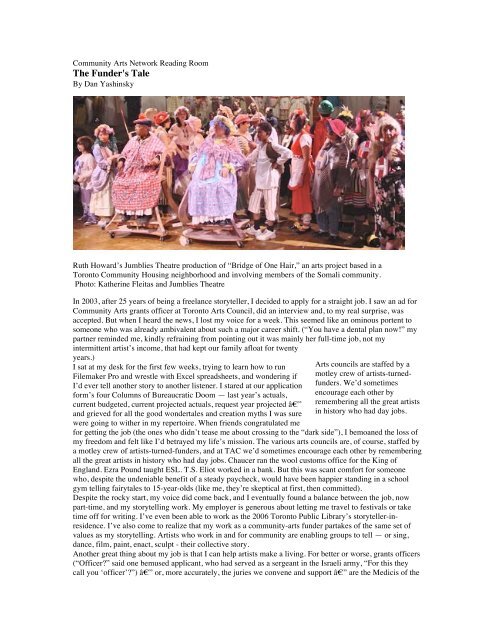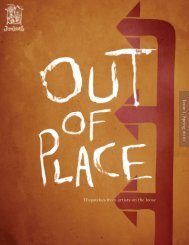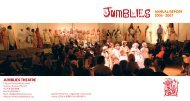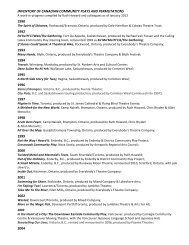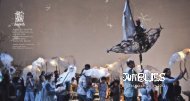Click here for PDF - Jumblies Theatre
Click here for PDF - Jumblies Theatre
Click here for PDF - Jumblies Theatre
Create successful ePaper yourself
Turn your PDF publications into a flip-book with our unique Google optimized e-Paper software.
Community Arts Network Reading Room<br />
The Funder's Tale<br />
By Dan Yashinsky<br />
Ruth Howard’s <strong>Jumblies</strong> <strong>Theatre</strong> production of “Bridge of One Hair,” an arts project based in a<br />
Toronto Community Housing neighborhood and involving members of the Somali community.<br />
Photo: Katherine Fleitas and <strong>Jumblies</strong> <strong>Theatre</strong><br />
In 2003, after 25 years of being a freelance storyteller, I decided to apply <strong>for</strong> a straight job. I saw an ad <strong>for</strong><br />
Community Arts grants officer at Toronto Arts Council, did an interview and, to my real surprise, was<br />
accepted. But when I heard the news, I lost my voice <strong>for</strong> a week. This seemed like an ominous portent to<br />
someone who was already ambivalent about such a major career shift. (“You have a dental plan now!” my<br />
partner reminded me, kindly refraining from pointing out it was mainly her full-time job, not my<br />
intermittent artist’s income, that had kept our family afloat <strong>for</strong> twenty<br />
years.)<br />
I sat at my desk <strong>for</strong> the first few weeks, trying to learn how to run<br />
Filemaker Pro and wrestle with Excel spreadsheets, and wondering if<br />
I’d ever tell another story to another listener. I stared at our application<br />
<strong>for</strong>m’s four Columns of Bureaucratic Doom — last year’s actuals,<br />
current budgeted, current projected actuals, request year projected —<br />
and grieved <strong>for</strong> all the good wondertales and creation myths I was sure<br />
were going to wither in my repertoire. When friends congratulated me<br />
Arts councils are staffed by a<br />
motley crew of artists-turnedfunders.<br />
We’d sometimes<br />
encourage each other by<br />
remembering all the great artists<br />
in history who had day jobs.<br />
<strong>for</strong> getting the job (the ones who didn’t tease me about crossing to the “dark side”), I bemoaned the loss of<br />
my freedom and felt like I’d betrayed my life’s mission. The various arts councils are, of course, staffed by<br />
a motley crew of artists-turned-funders, and at TAC we’d sometimes encourage each other by remembering<br />
all the great artists in history who had day jobs. Chaucer ran the wool customs office <strong>for</strong> the King of<br />
England. Ezra Pound taught ESL. T.S. Eliot worked in a bank. But this was scant com<strong>for</strong>t <strong>for</strong> someone<br />
who, despite the undeniable benefit of a steady paycheck, would have been happier standing in a school<br />
gym telling fairytales to 15-year-olds (like me, they’re skeptical at first, then committed).<br />
Despite the rocky start, my voice did come back, and I eventually found a balance between the job, now<br />
part-time, and my storytelling work. My employer is generous about letting me travel to festivals or take<br />
time off <strong>for</strong> writing. I’ve even been able to work as the 2006 Toronto Public Library’s storyteller-inresidence.<br />
I’ve also come to realize that my work as a community-arts funder partakes of the same set of<br />
values as my storytelling. Artists who work in and <strong>for</strong> community are enabling groups to tell — or sing,<br />
dance, film, paint, enact, sculpt - their collective story.<br />
Another great thing about my job is that I can help artists make a living. For better or worse, grants officers<br />
(“Officer?” said one bemused applicant, who had served as a sergeant in the Israeli army, “For this they<br />
call you ‘officer’?”) — or, more accurately, the juries we convene and support — are the Medicis of the
community arts movement. Corporate philanthropy, with a few notable exceptions like the Laidlaw<br />
Foundation, hasn’t lined up to provide support <strong>for</strong> unglamorous community-based art, and it’s hard to raise<br />
much earned revenue from a mosaic unveiling, a half-year theater project with refugees, a storytelling<br />
program <strong>for</strong> Afghani and Tamil seniors, or a hip-hop workshop <strong>for</strong> impoverished teenagers. Grants are how<br />
most community-based artists earn their daily bread. Although the funding available in Toronto is still far<br />
short of what the artists need and are ready <strong>for</strong>, it has been satisfying to work toward expanding TAC’s<br />
community arts program budget. It has increased by almost 50% from 2003 to 2006, from $561,300 to<br />
$810,000 (Canadian).<br />
I know the importance of grants first-hand, having received my share<br />
of them (rejections, too) throughout my career, sometimes at moments<br />
of acute financial peril. When the Ontario Arts Council gave me a<br />
Works-in-Progress grant to help finish my book “Suddenly They Heard<br />
Footsteps — Storytelling <strong>for</strong> the Twenty-first Century,” I was getting<br />
daily calls from Revenue Canada and Visa <strong>for</strong> unpaid taxes and bills. I<br />
saw the check and nearly wept with relief and jubilation.<br />
“Officer?” said one bemused<br />
applicant, who had served as a<br />
sergeant in the Israeli army, “For<br />
this they call you ‘officer’?”<br />
The most interesting part of my work is conversing with artists and animators and community leaders about<br />
their work. My education as a funder has come out of these conversations, and whatever knowledge I’ve<br />
gained about community arts has come from listening to how the artists themselves describe their<br />
philosophy, practice and passion <strong>for</strong> the work.<br />
Beauty and those Beastly Definitions: What is community arts?<br />
When I began my job, I sought out artists and animators and asked them to explain the term “community<br />
arts.” I quickly encountered a plethora of descriptions and names <strong>for</strong> the field. Even my program, after a<br />
review by an advisory group comprising some renowned artists and theorists, had recently been renamed<br />
Community Arts (from Arts in the Community). The guidelines they developed, after a year’s worth of<br />
discussion, stated: “In essence, Community Arts provides participants ways to experience the arts that are<br />
democratic, interactive, communicative, trans<strong>for</strong>ming, often delightful, and often with a critical edge.” It<br />
struck me at the time that, with all due respect to the advisory group, conveying the “essence” of something<br />
shouldn’t take such an over-abundance of adjectives.<br />
I have since read all the manifestos, newsletters (including the excellent one published by Community Arts<br />
Network), studies and reports I could find. In the 2006 program review the Canada Council <strong>for</strong> the Arts<br />
commissioned <strong>for</strong> its Artists and Community Collaboration Fund, author Laurie McGauley writes:<br />
[T]<strong>here</strong> is a wide spectrum of objectives, approaches, and intentions <strong>for</strong> the work. I think that most of them<br />
[i.e. the community-based artists] would agree that these practices involve artists and communities in some<br />
<strong>for</strong>m of collaborative creation of meaning, of beauty, and/or truth. Beyond that, the languages to describe<br />
and understand these approaches to art making are still evolving with the myriad ways of doing the work.<br />
Perhaps ironically <strong>for</strong> a discipline grounded in communal accomplishment, t<strong>here</strong> doesn’t seem to be much<br />
common ground among its leaders.<br />
T<strong>here</strong> are those who state that community arts must be a work of social and political trans<strong>for</strong>mation. They<br />
prefer to call it “community cultural development,” or “cultural animation.” A new grant program from<br />
Vancouver follows this line of thinking and refers to “art-based community development.” According to<br />
these theorists/practitioners, the artist’s role is to support and lead community members not only in an<br />
artistic production but simultaneously in a process that strengthens their sense of community, develops selfawareness<br />
and enables participants to articulate and achieve social and economic betterment. The measure<br />
of successful cultural animation is found in the changes participants are able to make in their lives through<br />
their involvement with an artistic experience.
I’ve met equally accomplished practitioners who<br />
eschew the political dimension of this work, and are<br />
happy to be gentle guides to the realm of the<br />
beautiful. If pressed, some of them admit that beauty<br />
itself has a radically trans<strong>for</strong>mative power. As one<br />
participant at Creative Works Studio (an arts program run out of St. Michael’s Hospital community<br />
psychiatry program) averred, “Beauty gets me out of bed in the morning.” These artists don’t necessarily<br />
use the term “community arts” or “cultural animation” to describe their work. They simply say they are<br />
artists who do their creative work in collaboration with people in community settings. Ruth Howard, one of<br />
Toronto’s most experienced and creative practitioners, describes herself as a “community-engaged artist,”<br />
but confesses that even that somewhat infelicitous term doesn’t really capture the nature of her approach.<br />
Yes, she engages with a community group — <strong>for</strong> example, the people living near Davenport-Perth<br />
Neighbourhood Centre, w<strong>here</strong> her group <strong>Jumblies</strong> <strong>Theatre</strong> has had a multi-year residency; or the residents<br />
of a Toronto Community Housing complex in south Etobicoke. But what she prefers is to define herself<br />
simply as an artist. At the recent Creators and Communities symposium, hosted by Toronto Arts Council<br />
Foundation, Ruth voiced her hope that one day the field would outgrow the need to qualify the art with the<br />
word “community.” It would be common knowledge that an artist can work <strong>for</strong> gallery exhibits or stage<br />
production or in collaboration with their neighbors and fellow citizens.<br />
Many of the creators in the field do, of course, have careers in theater, storytelling, literature, painting,<br />
filmmaking and so on. As a storyteller, <strong>for</strong> example, I’ve been working in community settings <strong>for</strong> many<br />
years without ever calling myself a community artist. I do a storytelling project I call a Telling Bee, w<strong>here</strong><br />
a group collects, tells, writes and publishes its oral stories: a community arts program par excellence. But<br />
t<strong>here</strong> have never been any strict divisions or definitions between the various parts of my career, and making<br />
a living has always been, as it is <strong>for</strong> many artists, a catch-as-catch-can affair of whatever work I could find:<br />
concerts, community work, festivals, schools, libraries, special projects, radio, writing, commission, (and<br />
even taking on part-time work as a grants officer!). Only when I began funding it, did I discover I had been<br />
doing “community arts” all along without having a name <strong>for</strong> it.<br />
So, what is the nature of a discipline that can generate such a wide range of self-descriptions? Why is<br />
community arts so difficult to encapsulate and define? It is important to remember that any artist working<br />
in community settings in the early 21st Century is a pioneer. These questions about purpose, process and<br />
definition are a sign of healthy evolution, not, as they can be in more established art<strong>for</strong>ms, a dreary<br />
symptom of competing doctrines and dogmas.<br />
Doing it <strong>for</strong> the Village<br />
It’s not that this is a novel artistic approach in human history. Artists have often, and in many cultures,<br />
expressed their creativity at a community level. South African theater artist John Kani (who also served as<br />
chair of their National Arts Council), described in a Globe and Mail interview the place of artists in African<br />
village culture:<br />
Africa is different. T<strong>here</strong> is no Broadway, and the community is what is important. When you become an<br />
artist, you become an artist in that village — a storyteller, a dancer, an entertainer, a percussionist. You’re<br />
doing it <strong>for</strong> the village. The fact that it may be seen by people coming from the neighboring village is just<br />
another embellishment.<br />
However, in our society, which has seen such rapid and drastic<br />
erosions of community life, this is a relatively recent discipline. I’m<br />
often reminded of a story I heard from my friend Ron Evans, a Metis<br />
oral historian, about the time an anthropologist came to an African<br />
village. They had just acquired their first television set and, <strong>for</strong> several<br />
weeks, they spent most of their time watching it. They neglected the<br />
old man by the fire, the griot who knew all of the tribe’s history and<br />
mythology. But, after awhile, people drifted back to the fire, and<br />
<strong>Jumblies</strong> <strong>Theatre</strong> production of “Bridge of One<br />
Hair.”Photo: Katherine Fleitas and <strong>Jumblies</strong><br />
<strong>Theatre</strong><br />
“Don’t you think the TV knows<br />
more stories than your old<br />
storyteller?”<br />
“Oh, yes. The TV knows more<br />
stories, but the storyteller knows<br />
me.”<br />
eventually t<strong>here</strong> was no one left by the television. The anthropologist, curious, asked one of the villagers,<br />
“Don’t you think the TV knows more stories than your old storyteller?” “Oh, yes,” came the reply. “The<br />
TV knows more stories, but the storyteller knows me.” Perhaps this need <strong>for</strong> immediate, intimate,<br />
neighbor-to-neighbor, homegrown culture is what gives <strong>for</strong>ce to the contemporary community arts<br />
movement.<br />
As a funder, it has been necessary <strong>for</strong> me find a nonpartisan framework <strong>for</strong> understanding the diverse<br />
practices and philosophies that mark community arts at this point in its evolution. After observing a wide
ange of Toronto-based arts projects and organizations, I will venture to say that the essence of this work is<br />
that artists working with community members extend the expressive vocabulary of the participants. It’s a<br />
simple but useful truth about community arts. The raison d’etre, the soul of community arts is to enable the<br />
group to gain a richer, deeper, more eloquent language of the imagination as a result of the art-making<br />
experience. What community members then choose to “speak” about (or dance, paint, sing, film, etc.) is, as<br />
it were, a secondary question. They may, and probably will, use this newly developed vocabulary in many,<br />
mostly unpredictable, ways. How and if it comes into play in the realms of social justice, social betterment,<br />
cultural affirmation, political action or purely subjective revelation may be somewhat out of the artist’s<br />
control.<br />
Although a good deal of art done in the name of “community cultural development” or “community arts”<br />
has a socially trans<strong>for</strong>mative purpose, art has a way of resisting value-added goals and messages. Will<br />
community arts produce concrete and measurable change in our social habitat? Perhaps. But what it will<br />
undeniably do, beyond all theories and definitions, is give us new ways, hard as they may be to measure, to<br />
express why those changes are necessary and new ways to make them. And at the most personal and<br />
intimate level, it may simply help a participant get out of bed in the morning <strong>for</strong> sheer love of beauty. My<br />
point is that the added values of social change and/or soul-trans<strong>for</strong>mation are built on the fundamental<br />
principle that making art in a community setting with a skilled artist as leader, will catalyze participants to<br />
find new ways to give voice to their individual and collective experiences. They gain and use a new<br />
language, a new vocabulary of the imagination, in whatever art <strong>for</strong>m they may be working.<br />
Community Arts Ontario ran a conference in May, 2003, and the two keynotes were American curator<br />
Mary Jane Jacob and Canadian composer R. Murray Schafer. Both of them gave brilliant talks, and their<br />
insights have guided my own thinking ever since. Jacob described her work curating a number of<br />
community-based arts projects <strong>for</strong> the Spoleto Festival in Charleston, South Carolina. The quality her<br />
artists shared, besides their tremendous creativity, was their ability to listen to community members. They<br />
didn’t go into their respective neighborhoods or community groups with pre<strong>for</strong>med ideas. They initiated,<br />
with Jacob’s guidance, a conversation, and from this process the artwork emerged. In every case, this<br />
process was anything but straight<strong>for</strong>ward. Like all good conversations, the artist and the community<br />
members spent a long time discovering each other’s interests, talents and common vision. In his talk,<br />
Schafer exemplifed this way of working. He described a community choir that he founded in a small<br />
Ontario town. Meeting people at their own musical level, working slowly and patiently, he was able to<br />
incubate and hatch some extraordinary musical — and<br />
neighborly — experiences.<br />
When I heard these two talks at the beginning of my<br />
work as a funder, it struck me very <strong>for</strong>cefully that,<br />
when artists of this caliber build a relationship in and<br />
with a community, wonderfully creative work will<br />
take place. Kristen Fahrig, a community-based artist<br />
who does projects in Toronto parks, was thinking of<br />
applying <strong>for</strong> a Community Arts Residency grant. I<br />
asked her what she was planning to do. “How can I<br />
know ahead of time?” she answered. “I have to talk to<br />
the people in the neighborhood first.” I’ve seen the<br />
fruits of such deeply collaborative work in projects all<br />
over Toronto. Ruth Howard brings Somali women<br />
together to explore poetry and textile art. She didn’t<br />
know ahead of time, but quickly learned in her contact<br />
with this community, that poetry is the central cultural<br />
expression <strong>for</strong> Somalis. Leah Burns, who did a mural<br />
project with youth at FoodShare’s Field to Table<br />
warehouse, states: “When I create artwork, I am<br />
contributing to an ongoing conversation.” As a<br />
funder, I’m guided by the profound belief that<br />
creative people will do imaginative and<br />
unprecedented work, whether the artistic production is<br />
destined <strong>for</strong> concert stages and art galleries, or<br />
whether it is done, like Kani’s African village artists,<br />
Archway by Kristen Fahrig in Toronto’s<br />
Sorauren Park. Photo by Kristen Fahrig
y, <strong>for</strong> and with your neighbors and fellow villagers.<br />
Form & Venue, or Boogeying up the Beach<br />
One of the least discussed but, to me, most interesting questions <strong>for</strong><br />
artists making art in and <strong>for</strong> community is which <strong>for</strong>ms of art-making<br />
are the most rewarding and expressive in this context. Why, <strong>for</strong><br />
example, is chamber music not a well-known community art, while<br />
mosaics, murals and choral music are? The simple answer is, of course,<br />
that chamber music requires specialized knowledge and skill to be<br />
per<strong>for</strong>med with any pleasure <strong>for</strong> the player and (especially!) the listener. A mosaic draws on a<br />
fundamentally human ability to recognize and manipulate color, shape and pattern. In my work at Toronto<br />
Arts Council, I’ve seen exceptional projects that employ the following arts: mosaic, theatre, choral singing,<br />
percussion, storytelling, poetry, spoken word, mural-painting, contemporary dance. I haven’t seen any<br />
community-based projects involving classical ballet, chamber or symphonic music, “academic” (<strong>for</strong> want<br />
of a better term; I mean “studied mainly by graduate students”) verse or gallery-quality drawing. This isn’t<br />
to say a gifted choreographer won’t one day use ballet to animate a grassroots arts project. We know that<br />
dance can work marvelously at a community level, with artists like Judith Marcuse and Liz Lerman<br />
working with an incredible range of participants. But<br />
they don’t tend to get their people up on point.<br />
The arts that seem to work best at a highly<br />
participatory level are the ones that people already<br />
know how to do. They draw on an expressive<br />
vocabulary that is hardwired into our bodies, souls<br />
and voices: rhythm, color, pattern recognition, roleplaying,<br />
vivid and memorable speech (i.e., <strong>for</strong> poetry<br />
and storytelling), an ability to shake, shimmy and<br />
move to music. When a community artist brings<br />
his/her creative energy to a group of fellow citizens,<br />
they awaken and conjure <strong>for</strong>th an in<strong>here</strong>nt capacity<br />
<strong>for</strong> the artistic modes that have belonged to the human<br />
race since we boogied and hummed our way up the<br />
beach from the primordial bog, doodling in the sand<br />
all the way.<br />
Another attribute of community arts is that the end<br />
results are always — or should be — more than the<br />
sum of their parts. A participatory mosaic can be<br />
constructed by a large number of individual pieces,<br />
only some of which are distinguished in a<br />
conventional aesthetic sense. Yet, placed in the<br />
context of the whole piece, even the less skillful bits<br />
have their place, and the finished mosaic can be<br />
astonishingly beautiful and satisfying.<br />
• Red Pepper Spectacle Arts, a Toronto-based<br />
arts company, did a community-wide mosaic<br />
project at St. Stephen’s Community House,<br />
in the heart of Kensington Market. Every<br />
participant in every program designed and<br />
created a part of the mosaic, which is called<br />
River of Dreams. It winds through each floor<br />
of the three buildings that comprise St.<br />
Stephen’s, and is an eloquent record of this<br />
The arts that seem to work best<br />
at a highly participatory level are<br />
the ones that people already<br />
know how to do.<br />
River of Dreams project by Red Pepper Spectacle<br />
Arts. Photos courtesy of Red Pepper Spectacle<br />
Arts<br />
diverse community’s collective vision. When you behold the art, you don’t see a series of<br />
individual pieces; you see the aptly named “river” of color and pattern flowing through the halls<br />
and rooms.<br />
• I saw this process at the Villawayz Community Arts Centre, located in a bleak Toronto<br />
Community Housing area in the inner suburbs of Toronto. The animator, Suzie Tarlattini, had<br />
young people in the neighborhood do poetry, photography, oral-history collection and visual art
<strong>for</strong> about a year. They created the Villawayz Community Album, which everyone in the<br />
neighborhood received. The book as a whole is a moving, funny, wise and beautiful chronicle of a<br />
community that faces extreme challenges. Like the community it celebrates, the Album is very<br />
much more than the sum of its parts.<br />
• The Four in Hand storytellers, working as artists-in-residence at Rexdale Women’s Centre (which<br />
serves one of Toronto’s most impoverished and multicultural neighborhoods), brought together an<br />
amazingly diverse group of seniors, and helped them share their folk traditions. Many of them had<br />
never told their stories <strong>here</strong> in Toronto. Hearing and telling their stories, they began to create a<br />
new oral tradition, one that could only have sprung <strong>for</strong>th from the Rexdale community they all live<br />
in.<br />
Slow Art<br />
I want to end these observations by commenting on the place of the professional artist and animator in<br />
community arts. In the successful projects that TAC has funded, t<strong>here</strong> is always an animator working<br />
alongside the artist. The role of the animator is to bring the artist and the community members together,<br />
build trust and mutual respect, ensure the group stays cohesive and inclusive, make sure t<strong>here</strong> are cookies<br />
and bus tickets, observe and help evaluate the work. For the field to develop to its fullest potential, I think<br />
funders have to understand the necessity of the animator’s role, as well<br />
as that of the artist.<br />
We also have to recognize and honor the role of artistic mastery in<br />
community arts. Sometimes I’ve seen artists downplay their leadership<br />
role, as if it’s bad grace to claim too much credit <strong>for</strong> a collaborative<br />
production. They are the opposite of Yogi Berra, who claimed, on<br />
winning the World Series, that “I couldna done it wit’out the players.”<br />
But it is precisely this opportunity <strong>for</strong> community members to work<br />
For the field to develop to its<br />
fullest potential, I think funders<br />
have to understand the necessity<br />
of the animator’s role, as well as<br />
that of the artist.<br />
alongside exceptionally creative artists that can give such a thrill to community arts. My friend, dancer<br />
Rina Singh, was in the Himalayan foothills studying traditional dance <strong>for</strong>ms. She was visiting a certain<br />
town w<strong>here</strong> the greatest percussionist of the region happened to work at a private school. It was a festival<br />
day, and Rina saw that many young girls were practicing their dance on a lawn beside the school. The great<br />
artist noticed them, stopped what he was doing, picked up a drum and began to play <strong>for</strong> a meadowful of<br />
five-year-olds. Afterwards, Singh asked him why he, who was such a renowned virtuoso, played <strong>for</strong> the<br />
children. “The youngest ears,” he replied, “must hear the best.”<br />
It is the same when a gifted artist brings his/her expressive <strong>for</strong>ces into a community level. It isn’t a matter<br />
of setting up a hierarchy of talent, or using the old, romantic model of the Artist Hero. Of all people<br />
working in the arts, community artists are the first to resist the top-down model of art making. Yet it is vital<br />
to acknowledge the truth that gaining skill and wisdom in any of the arts takes a long time. Artists serve<br />
long apprenticeships, and becoming an artist is a complex, arduous process. While celebrating the great<br />
accomplishments and talents of participants, we must equally honor the mastery of the artists who instigate<br />
and guide such work. Not all artists, of course, choose to do collaborative work, nor have all artists the<br />
passion and patience to lead hundreds of participants in a mosaic project, or coax moving verse out of shy<br />
teenagers, or listen to the folktales carried by Afghani and Tamil seniors. Those who do choose to use their<br />
creativity in this way have, in addition to their artistic profiency, an extraordinary capacity to listen to the<br />
hidden stories, the quieter voices of the community. This way of working should be recognized — and<br />
supported — as much as the art shown on gallery walls or presented on concert stages.<br />
Learning to fund community arts is a work in progress, reflecting the experimentation and continuous reinvention<br />
that marks the field itself. The heart of the work depends on artists and community members<br />
having the time to build a creative relationship, and time, <strong>for</strong> freelance artists trying to feed their kids, is<br />
quite literally money. If I may go back to Africa <strong>for</strong> a last proverb, a man from Ghana once told me, “The<br />
white man has the watches, but the black man has the time.” It is a good lesson <strong>for</strong> community-arts funders.<br />
You could almost call this kind of artistic work the “slow art” movement. Building trusting and creative<br />
relationships with community members takes time, and then more time. T<strong>here</strong> are no shortcuts or instant<br />
results. Only if they have enough time can artists and participants catalyze mutual discoveries, bring all<br />
their skills and ideas to the work, make something beautiful and spark change in the community. In<br />
Toronto, and across Canada, I’ve been privileged to meet some wonderfully gifted artists; the cooks, as it<br />
were, who are able to prepare — slowly, and, one hopes, with decent grant support -- great artistic feasts<br />
with the whole community working together in the kitchen.
Dan Yashinsky is a storyteller, author and community organizer. He currently works part-time at the<br />
Toronto Arts Council as the community arts program officer. In l999 he received the Jane Jacobs Prize <strong>for</strong><br />
his work with storytelling in the community. He is the author of “Suddenly They Heard Footsteps:<br />
Storytelling <strong>for</strong> the Twenty-first Century” (University Press of Mississippi, 2006).<br />
A shorter version of this article appeared in The New Quarterly’s Arts and Activism issue, Winter,<br />
2006/07.


